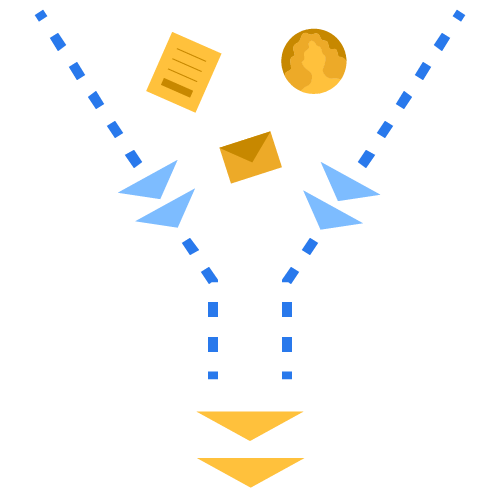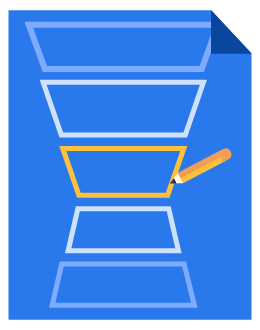5 Steps to Using a Blank Sales Funnel Template to Boost Conversions


Ben Darling
This post was originally published in June 2019 and has been updated for accuracy and comprehensiveness.
The customer begins their purchasing journey at the top of the sales funnel. They continue through the funnel until they have made a purchase decision, which can be fostered by the company’s sales and marketing efforts. By downloading our blank sales funnel template, you will be able to visualize the specific steps customers take to buy their product or service.
The sales funnel is a staple tool that has been around for years and will continue to help companies thrive.
As B2B companies move towards an account-based strategy (focusing on specific companies instead of selling to a large demographic), it’s essential to stand out by understanding where customers are in the funnel and what the company can do to convert them into purchasing.
Create your own sales funnel, fill out each step based on your company, and use it to strategize your sales and marketing efforts. Download our free blank sales funnel template below. Read on to learn ways you can use your sales funnel to grow your business.


Download your free Sales & Marketing Funnel Template
Download our free sales and marketing funnel template. Customize it to your company’s needs and start strategically planning your sales and marketing efforts.
B2B Sales Funnel Stages
Learn more about your prospect needs, how you can strategize your marketing efforts, and identify ways you can measure your success by following these 5 steps.
Step 1: Awareness Stage - User Pain Points
What you can expect your customers to do in the awareness stage
When prospects enter the first stage of the sales funnel, they realize their pain point — which your solution could solve. When prospects are aware of the problem they are facing, they start to research what products or services may help them.
Usually, the prospect has not discovered your company and may not have even considered making a purchase to solve their problem.

How you can get connected with the buyer in the awareness stage
It’s important to offer a solution to the prospects’ issue by informing them of your company or product and offering it as a potential solution.
To start, you will need to understand what types of buyers are suitable for your product or service. You can figure this out by defining your B2B buyer persona, which will allow you to narrow your scope and turn leads into conversions.
Before you can decide which marketing tactics to use, you first need to specify the companies you’ll be targeting, their specific roles, their priorities, and what makes them finalize a purchase. When you gather all of this information from creating your B2B buyer persona, you can figure out which marketing tactics will make sense.
Tactics to reach buyers in the awareness stage:
Decide on what strategy you want to use before you create marketing materials. The best approach for B2B is known as the all-bound strategy. This strategy utilizes inbound marketing (enticing leads to reach out to you) and outbound marketing (contacting leads first). Tactics of the all-bound marketing strategy for a B2B sales funnel include:
- Blogging: Answer the questions of your buyer persona by regularly posting free, educational blog posts to your website
- Gated content: Obtain the website visitors’ contact information by offering helpful content downloads (like a worksheet) in exchange for them filling out a contact form
- SEO: Use SEO best practices so you can optimize your website content to have a high ranking on search engines
- Paid ads: Use sponsored ads on Google and your company’s social media accounts to lead potential buyers to your product pages and content download pages
- MQL follow-up: When a visitor leaves their contact information, a sales representative (SDR) should call the website visitor in hopes that they will schedule a sales appointment or demo
- Cold calling: Another way to schedule a sales appointment or demo is for SDRs to call on cold leads based on target accounts in your database
Step 2: Consideration - Develop a Value Proposition
What you can expect your customers to do in the consideration stage
By now, the prospect may have a few options for solving their problem; they need to decide which option best suits their needs.
They are investigating how to use competing solutions and consider which options would be a good fit for them or their company.

How you can get connected with the buyer in the consideration stage
Now is the time to show your potential customers why your solution is the best option and will solve their pain points.
Your detailed research on your buyer persona will enable you to understand the prospects’ challenges at hand, their priorities, and their most relevant decision drivers.
Focusing on their pain points will help you create a value proposition that convinces them your company or product is the best option for them.
Tactics to get prospects to consider your solution over others:
Ensure your touchpoints in your all-bound strategy give prospects insight into your value proposition and how they are aligned with their specific needs. Some tactics include:
- Blogging: Continue posting relevant and educational blog posts. However, when you know a prospect is in the consideration phase, add blog posts that compare your solution to similar alternatives
- Retargeting ads: Set aside a part of your ad budget for retargeting ads. This way, you can intentionally target consumers who have already visited your website or specific pages of it
- Email marketing: Using a platform like Marketing Cloud Account Engagement (formerly known as Pardot) to set up complex drip campaigns will nurture leads with automated email campaigns and send those campaigns at the right time and to the right prospects
- Sales collateral: Offer branded documents — such as product one-pagers, FAQs, and case studies to answer prospects’ questions and concerns
- Prospect discovery: While SDRs follow up with leads to set a meeting and salespeople begin to meet with their prospects, it’s important to ask purposeful discovery questions. You can use this to gather information from the lead and nurture them through the rest of the funnel stages
- Lead rating: Track your leads’ progress through the sales funnel, their interest in your product or service, and their purchasing intent by setting up a consistent system for rating leads through your CRM or automation platform
Step 3: Decision - Win Over the Committee
What you can expect your customers to do in the decision stage
By this stage of the funnel, you have narrowed down the leads who might actually buy your solution. These prospects are almost ready to commit to your solution, but they are still debating whether or not to finally invest.
Typically, in B2B sales, a purchase like this involves an entire buying committee. It’s your responsibility to win the support of everyone who has a say.

How you can get connected with the decision-maker in the decision stage
Close the deal by eliminating any final concerns or barriers to purchase. It’s crucial that you convince the prospects of the business value your solution will provide.
Support your prospects through the funnel by helping them overcome their organizational challenges. For instance, you could help them budget spending, develop a realistic implementation schedule, or win over the internal stakeholders.
This process tends to be longer than selling to just one buyer. You may have to gain confirmation from high-level decision-makers or even get contracts from the legal department. We find that researching each of the prospects’ buyer personas ensures that you know their specific pain points and priorities. Find out which role will care more about the technical side of your product and which will prioritize the business impact.
Tactics to get decision-makers to seal the deal:
Try some of these tactics to help lead prospects through the decision stage:
- Case studies: Illustrate how your solution has been effective for customers. Case studies will be especially useful when giving the prospect examples of how your solution has been successful in the past
- CRM notation: Continually tracking every interaction with each potential lead on the buying committee through your CRM system will help you track incremental progress in this stage of the sales funnel
- Outside sales: While the focus has shifted to mainly inside sales strategies, an in-person sales presentation or demo could be the thing that solidifies the sale
- Negotiation: When possible, negotiating discounts or trial periods may help persuade the decision-makers to commit to trying your solution. However, be mindful of your limits when making these deals
Step 4: Growth - Build Effective Business Relationships
What you can expect your customers to do in the growth stage
In the growth stage, your buyers have bought your solution and are beginning to adopt and implement your product or service.
Buyers who are properly onboarded are not only more likely to actually use your solution but also be more likely to purchase your service or product again.

How you can get connected with the buyer in the growth stage
The job is not done when the sale is made. The modern sales funnel emphasizes the potential increase in customer lifetime value (CLV) in the post-sale stages. After all, it costs 5x less to retain a customer than to acquire a new one.
The goal of the growth stage is to grow the relationship between your company and your current customer base. By giving your customers a positive experience from the start of their purchase, it will keep them coming back to your solution.
This is also a great time to offer your customers options to upgrade or customize their product or service through upselling and cross-selling techniques.
Tactics to nurture a business relationship:
This list of tactics is a great way to satisfy and retain your paying customers:
- Onboarding documentation: Supporting new customers’ experience with easy-to-follow onboarding documents so they can effortlessly implement your solution
- Customer knowledge base: Use a self-service portal on your website to proactively organize all information, resources, instructions, or answers that your new customer might have
- Customer success management: Assign a dedicated representative to communicate directly with new customers and guide them through the configuration and implementation processes
- Training programs: Ensure your customer consistently gets the most out of your solution by offering initial and ongoing training solutions
Step 5: Delight - Foster Brand Loyalty
What you can expect your customers to do in the delight stage
Customers in the delight stage are consistently using your product or service and expecting your company to continue meeting their needs and supporting their experience.
The delight stage is essential to your company’s success. By now, new customers may be developing brand loyalty and, most importantly, recommending your solutions to their peers.

How you can get connected with the buyer in the delight stage
This is your opportunity to foster customer loyalty and advocacy by encouraging and incentivizing renewals and referrals. If your goal is long-term growth, it’s important to focus on and prioritize existing customer relationships.
Growing current customer relationships can be done by guaranteeing satisfaction. Spending time maintaining and strengthening your customer relationships will help them feel appreciated, which fosters brand loyalty.
The delight stage should not solely fall on the shoulders of a salesperson. The whole team is responsible for creating strong customer relationships.
When customers renew their use of your solution or refer a friend to your company, the sales funnel process begins again.
Tactics to delight your customers:
Delight your customers by using some of these tactics:
- Regular health checks: Consistently check in with customers by phone or email to check that your solution is still working properly and offer suggestions for improvement
- Request feedback: Ask customers for regular feedback or reviews on platforms like Google, G2 Crowd, and Clutch. co
- Exclusive offers: Show your appreciation for your loyal customers by offering exclusive deals, especially as a way to encourage them to refer a new customer
- Email lists: Keep your brand connected to customers by sharing new products or company updates with customers who sign up for an email list
- Multi-channel support: Stay connected with your customers by offering comprehensive customer support through all of your buyers’ favorite channels (phone, email, web chat, social media, etc.)

Subscribe to EBQ's Bimonthly Newsletter

Subscribe to EBQ's Bimonthly Newsletter
How to Master Sales Funnel Optimization
Once you have downloaded and filled in our sales funnel template, it’s helpful to consistently measure, analyze, and optimize the process.
This will allow you to ensure your customer journeys are properly mapped and that the company is not missing any chance to bring prospects closer to a purchase.
5 KPIs to measure throughout your sales funnel
Here is what you should measure in each step of your funnel:
- Lead-to-prospect conversion ratio: This measures the percentage of leads that have moved on to become potential prospects. Your goal is to have a high conversion rate, which will come from nurturing your leads through each step of the funnel
- Cost-per-lead and acquisition cost: Track this metric to determine the profitability of your sale. Pay attention to high acquisition costs; they may lower the return on investment made by your sales and marketing tactics
- Sale velocity: Measuring the sale velocity is a way to see how quickly your lead moves through your sales funnel. This KPI can be helpful to see where your leads are getting stuck and how you can edit your funnel for efficiency
- Customer lifetime value: Monitor your customer lifetime value to increase your company’s long-term profits. This will show you the sum total of revenue you can expect from a customer over their lifetime
- Conversion rate: This may be one of the most important KPIs to measure, as it helps you see how many leads eventually turn into paying customers

Download your free Sales & Marketing Funnel Template
Download our free sales and marketing funnel template. Customize it to your company’s needs and start strategically planning your sales and marketing efforts.
Become a Sales Funnel Expert
Take some time to fill out the blank sales funnel template so you can enhance your B2B sales and marketing strategies — thus creating a clear visualization of your customers’ journey. By identifying and resolving the users’ pain points, implementing a strong value proposition, winning over the entire decision-making committee, fostering strong business relationships, and creating brand loyalty, your company will successfully lead each prospect through every stage of the funnel.
Additionally, consistent monitoring of your KPIs optimizes your sales funnel and ensures that your strategies are efficient and effective.
If your sales funnel needs improvement, contact an EBQ Business Consultant. We can help optimize your sales and marketing strategies based on our 16+ years of experience.
